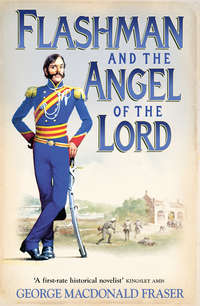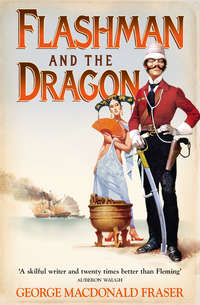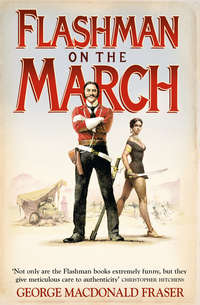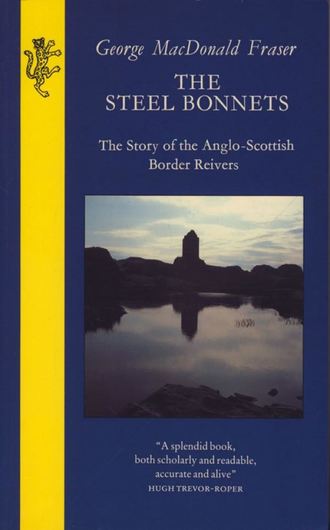
Полная версия
The Steel Bonnets


George MacDonald Fraser
THE STEEL BONNETS
The Story of the Anglo-Scottish Border Reivers
“If Jesus Christ were emongest
them, they would deceave him,
if he woulde heere, trust and
followe theire wicked councells!”
RICHARD FENWICK 1597

COPYRIGHT
HarperCollinsPublishers 1 London Bridge, London SE1 9GF
www.harpercollins.co.uk
Previously published in trade paperback by Harvill 1989
Reprinted five times
First published by Harvill 1986
First published in Great Britain by
Barrie &Jenkins 1971
Copyright © George MacDonald Fraser 1971
The Author asserts the moral right to
be identified as the author of this work
A catalogue record for this book is
available from the British Library
All rights reserved under International and Pan-American Copyright Conventions. By payment of the required fees, you have been granted the nonexclusive, nontransferable right to access and read the text of this e-book on-screen. No part of this text may be reproduced, transmitted, downloaded, decompiled, reverse engineered, or stored in or introduced into any information storage and retrieval system, in any form or by any means, whether electronic or mechanical, now known or hereinafter invented, without the express written permission of HarperCollins e-books.
Ebook Edition © JUNE 2012 ISBN 9780007474288
Version: 2018-01-16
HarperCollinsPublishers has made every reasonable effort to ensure that any picture content and written content in this ebook has been included or removed in accordance with the contractual and technological constraints in operation at the time of publication.
DEDICATION
In memory of
Corporal IKE BLAKELEY
of the Border Regiment, killed
by a Japanese sniper at Kinde Wood,
Central Burma, 1945, and for
BOB GRAHAM and SLIM IRVINE
wounded in the same action.
MAPS
The Border Clans
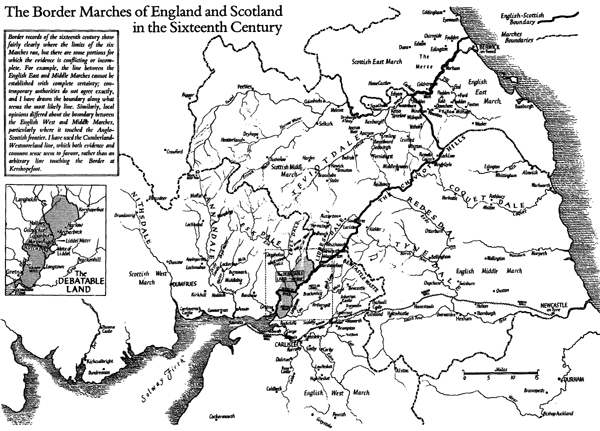
CONTENTS
Cover
Title Page
Dedication
Maps
Introduction: The Border Reivers
Part One: THE MAKING OF A FRONTIER
I: Hadrian draws the line
II: The moving boundaries
III: England v. Scotland, 1286–1500
Part Two: PEOPLE OF THE MARCHES
IV: Border country
V: “A martial kind of men”
VI: Food and shelter
VII: The riding surnames
VIII: Hands across the Border
IX: Bangtail and company
X: The game and the song
Part Three: “SHAKE LOOSE THE BORDER”
XI: Lance and steel bonnet
XII: How the reivers rode
XIII: Nothing too hot or too heavy
XIV: A parcel of rogues (William Armstrong of Kinmont, Walter Scott of Harden, Geordie Burn)
XV: Carleton’s raid
XVI: Hot trod and red hand
XVII: The ability to kill
XVIII: The Wardens of the Marches
XIX: Leges Marchiarum
XX: Days of truce
XXI: The unblessed hand (Maxwells v. Johnstones, Grahams v. Irvines, Kerrs v. Scotts, Scotts v. Elliots, Selbys v. Grays)
XXII: Terror, blackmail, kidnapping and “decaie”
XXIII: “Fyre and sword upon Tuesday next”
Part Four: THE LONG GOOD-NIGHT, 1503–1603
XXIV: Flodden and after. Biographical note on Thomas Dacre
XXV: The Devil, and Lord Angus
XXVI: Armstrongs in action
XXVII: A rope for Black Jock
XXVIII: The violent peace
XXIX: The road to Solway Moss. Note on the prisoners of Solway Moss
XXX: The rough wooing
XXXI: Wharton and Maxwell
XXXII: England’s grip broken
XXXIII: The Debateable Land
XXXIV: The women’s touch
XXXV: Queen on the Marches
XXXVI: The Countess and the reivers
XXXVII: The last armies
XXXVIII: Reidswire and Windygyle
XXXIX: The stirring world of Robert Carey
XL: “Fyrebrande”
XLI: Lances to Carlisle
XLII: The Carleton Brothers
Part Five: THE MIDDLE SHIRES
XLIII: Carey’s ride
XLIV: Breaking the Border
XLV: Malefactors of the name of Graham
XLVI: The thieves dauntoned
XLVII: After the riding
Appendix I: The Archbishop of Glasgow’s “Monition of Cursing” against the Border reivers
Appendix II: The ballad of Kinmont Willie
Bibliography
Glossary
Index
Acknowledgements
About the Author
By the Same Author
Copyright
About the Publisher
INTRODUCTION
The Border Reivers
At one moment when President Richard Nixon was taking part in his inauguration ceremony, he appeared flanked by Lyndon Johnson and Billy Graham. To anyone familiar with Border history it was one of those historical coincidences which send a little shudder through the mind: in that moment, thousands of miles and centuries in time away from the Debateable Land, the threads came together again; the descendants of three notable Anglo-Scottish Border tribes—families who lived and fought within a few miles of each other on the West Marches in Queen Elizabeth’s time—were standing side by side, and it took very little effort of the imagination to replace the custom-made suits with leather jacks or backs-and-breasts. Only a political commentator would be tactless enough to pursue the resemblance to Border reivers beyond the physical, but there the similarity is strong.
Lyndon Johnson’s is a face and figure that everyone in Dumfriesshire knows; the lined, leathery Northern head and rangy, rather loose-jointed frame belong to one of the commonest Border types. The only mystery is when the “t” which distinguishes Border Johnstones from the others of the name was dropped from his surname. Billy Graham has frequently advertised his Scottishness, perhaps a little thoughtlessly, since there are more Grahams on the southern side of the line than on the northern, but again, the face is familiar.
Richard Nixon, however, is the perfect example. The blunt, heavy features, the dark complexion, the burly body, and the whole air of dour hardness are as typical of the Anglo-Scottish frontier as the Roman Wall. Take thirty years off his age and you could put him straight into the front row of the Hawick scrum and hope to keep out of his way. It is difficult to think of any face that would fit better under a steel bonnet.
None of this, possibly, is capable of definite proof, but one can at least say that the names go with the faces, and that Johnson and Nixon especially are excellent specimens of two distinct but common Border types.
It seems reasonable to suppose that the people of the Border country have not changed a great deal, physically or characteristically, in four centuries. Although the frontier line still lies between Scot and Englishman, they are now considerably mixed in the racial sense, particularly on the English side. A good half of the people of Carlisle are at least partly Scottish; there are as many Armstrongs and Johnstones as there are Forsters and Hetheringtons. But the racial composition of the Borderland generally has not altered so very much; the Elliots and Fenwicks, Bells and Nixons, Littles and Scotts, Maxwells and Kerrs (and Carrs) are still where they were in the sixteenth century, and although the Border is in many ways an even greater mental barrier than it once was, one can say that both sides together form a distinct and separate cultural and social bloc which is apart from the rest of the British people.
It is always dangerous to generalise, and one hesitates to state too dogmatically what the difference is between the Borderers1 and the rest. They are not, to put it as tactfully as possible, the most immediately lovable folk in the United Kingdom. Incomers may find them difficult to know; there is a tendency among them to be suspicious and taciturn, and the harsh Border voice, whether the accent is Scots or English, lends itself readily to derision and complaint. No doubt there are Cumbrians who are gay, frivolous folk, and Roxburghshire probably has its quota of fawning, polished sophisticates: they are in a minority, that is all.
This is perhaps a personal point of view; it is, nevertheless, being expressed by one who is a Borderer born and raised in spite of his name. And it can always be disputed. On the credit side, there is a Border virtue which in the human scale should outweigh all the rest, and it is simply the ability to endure, unchanging. Perhaps the highest compliment that one can pay to the people of the Anglo-Scottish frontier is to remark that, in spite of everything, they are still there.
For if there are qualities in the Border people which are less than amiable, it must be understood that they were shaped by the kind of continuous ordeal that has passed most of Britain by. That ordeal reached its peak in the sixteenth century, when great numbers of the people inhabiting the frontier territory (the old Border Marches) lived by despoiling each other, when the great Border tribes, both English and Scottish, feuded continuously among themselves, when robbery and blackmail were everyday professions, when raiding, arson, kidnapping, murder and extortion were an important part of the social system.
This had very little to do with war between the two countries, who spent most of the century at peace with each other. It was a way of life pursued in peace-time, by people who accepted it as normal. It meant that no man who lived between the Scottish Southern Uplands and the Pennines could walk abroad unarmed in safety; no householder in all the Marches could go to sleep secure; no beast or cattle could be left unguarded. The seamen of the first Elizabeth might sweep the world’s greatest fleet off the seas, but for all the protection she could give to her Northumbrian peasants they might as well have been in Africa. While young Shakespeare wrote his plays, and the monarchs of England and Scotland ruled the comparatively secure hearts of their kingdoms, the narrow hill land between was dominated by the lance and the sword. The tribal leaders from their towers, the broken men and outlaws of the mosses, the ordinary peasants of the valleys, in their own phrase, “shook loose the Border”. They continued to shake it as long as it was a political reality, practising systematic robbery and destruction on each other. History has christened them the Border reivers.2
How this violent and incongruous social condition arose in the comparatively recent history of the British Isles is a strange, frequently misunderstood story.
The English-Scottish frontier is and was the dividing line between two of the most energetic, aggressive, talented and altogether formidable nations in human history. Any number of factors, including geography, race movement, and the Romans decided where the line should be, and once it was there, on the map, on the countryside, and in men’s minds, the stage was set. Possibly English on one side and Scots on the other could have lived peaceably as national neighbours—indeed, for long periods they did; but it was not in the nature of either of the beasts to stay quiet for long. No doubt they ought to have done; successive English kings thought so, and did their utmost, by fair means and foul, to bring about the amity and unity which eventually prevailed. At least, unity prevailed; amity is a more questionable commodity, especially north of the Border, even today.
But in the making of Britain, between England and Scotland, there was prolonged and terrible violence, and whoever gained in the end, the Border country suffered fearfully in the process. It was the ring in which the champions met; armies marched and counter-marched and fought and fled across it; it was wasted and burned and despoiled, its people harried and robbed and slaughtered, on both sides, by both sides. Whatever the rights and wrongs, the Borderers were the people who bore the brunt; for almost 300 years, from the late thirteenth century to the middle of the sixteenth, they lived on a battlefield that stretched from the Solway to the North Sea. War after war was fought on it, and this, to put it mildly, had an effect on the folk who lived there.
What this effect was will be examined more closely later; for the moment it is enough to say that constant strife, or the threat of it, bred up a race of hard people along the Border line. They lived in a jungle, and they had to live by jungle rules. This is not to excuse them, if that were necessary, but to explain. If a man cannot live, and ensure that his family lives, within the law, he has no alternative but to step outside it.3 It was inevitable that the way of life which the Borderer had to follow in time of war should be carried over into what was nominally peace-time; habits are hard to break, and here they became so deeply ingrained as to be almost instinctive.
By the sixteenth century robbery and blood feud had become virtually systematic, and that century saw the activities of the steel-bonneted Border riders—noble and simple, robber and lawman, soldier and farmer, outlaw and peasant—at their height.
In the story of Britain, the Border reiver is a unique figure. He was not part of a separate minority group in his area; he came from every social class. Some reivers lived in outlaw bands, but most of them were ordinary members of the community, and they were everywhere in the Marches. The reiver was a rustic, but in some ways a remarkably sophisticated one. In a modern charge sheet he would probably be described as an agricultural labourer, or a small-holder, or gentleman farmer, or even a peer of the realm; he was also a professional cattle-rustler. In addition he was a fighting man who, on the evidence, handled his weapons with superb skill; a guerrilla soldier of great resource to whom the arts of theft, raid, tracking and ambush were second nature.
But he was also often a gangster organised on highly professional lines, who had perfected the protection racket three centuries before Chicago was built. He gave the word “blackmail” to the English language. For many generations he and his people formed almost a lawless state within, or between, two countries, and in spite of all that was done for their suppression, and the complicated international arrangements that were made for their regulation, they flourished until England and Scotland came under one king.
Of course they were checked and stayed, fined and hanged, pursued and evicted, when authority had the time and the strength to exert itself, but this was no more than a staunching process; the hoof-beats had not died away before they were drumming again. From the late Middle Ages until the end of Elizabeth’s reign the Marches of England and Scotland were a perpetual badman’s territory, dominated by raiders and free-booters, plunderers and rustlers, Border lords and outlaw riders.
Because it was so localised, and is now so long ago, and because the Border ballads and legends have cast a gloss of romance over it, there is a tendency to regard the high midnight of the Border reiver as a stirring, gallant episode in British history. It was not like that; it was as cruel and horrible in its way as Biafra or Vietnam. And the most unusual feature of it was that this was not, at its zenith in the sixteenth century, a case of an innocent, defenceless community in the grip of a war, or of a small criminal element’s reign of terror—the Border folk made the war and terror on themselves; it was as much a part of their lives as agriculture. It follows that they were unusual folk, and that the stamp of the old days is on them still. If the Borderer is closer and tougher and dourer than his fellow-countrymen, it is because he is the descendant of men and women who lived by and in the shadow of raid and theft and bloody murder.
How the frontier society was born and grew, how Border raiding became a systematic thing, how the two governments tried to deal with it, how it fitted into the politics and diplomacy of the two realms and into the social life of the area, and how, almost suddenly, it passed away, is the theme of this book. Some of the stories have been told before, not always accurately; immense scholarship has been applied to various aspects of the subject, and I don’t wish simply to re-tell old tales, or to presume to improve on the researches of eminent historians. But it has seemed to me, knowing something of the Border and its literature, romantic and factual, that the reivers themselves have never been given a history, and that there are still points to be made, and stories to be told, perhaps in a rather different way.
There is a school of Border writers who may be called the romantics. The first of these is the greatest man the region ever produced, Sir Walter Scott. It is not too much to say that Scott made the legendary Border as most people vaguely understand it; a land of brave men and daring deeds, of gothic mystery and fairytale beauty, of gallant Scot and sturdy Saxon, of high ideals and sweet dreams clothed in ballads that are the very heart of a nation’s poetry. All perfectly true, in its way, but not the whole story. Scott knew the other side as well, the blood and the terror and the cruelty and the crime. He, after all, understood the Borderland as probably no one else has ever done, and no other writer or scholar has done anything like as much to rescue its real history from the past. But he was a professional romantic; it was not his job to view his subject as it snarled at him over the business end of a Liddesdale lance; there were no Whartons or Scropes descending on Abbotsford by night to ransack and burn it.
One concludes that most of the romantic writers on the subject had never seen a sword or axe wielded in earnest, or seen a hanging, or a thatch burned in anger, or wakened in terror to the sound of hoof-beats. That was not their fault; but if they had known these things, a little of their enthusiasm for the glamorous side of the Border story might have been modified. Nor is patriotism, a common resort of the apologist, of much use in this context; patriotism was, as will be seen, frequently well down the scale of the Borderer’s priorities.
So, while admitting that it is difficult not to see the romantic side, it is important to keep it in perspective.
At the other extreme from the romantics are the historical specialists, who have dealt with various parts of the Border question—international politics, administration, military history, genealogical research, and a host of much smaller topics which have been examined in minute detail. These matters have been exhaustively done, but, quite rightly, they have not usually been concerned with what is called human interest. The Scottish policy of Henry VIII is a fascinating thing, offering as rich a field to the psychiatrist as to the historian, but I am less concerned with the effect that it had on, say, Franco-Scottish relations than with the more immediate and dramatic impact which it had on the good wife of Kirkcudbright who, during a skirmish near her home, actually delivered her husband up to the enemy for safe-keeping. Obviously one must take account of the machinations of Walsingham and James VI and I, but the prime consideration for me is how Nebless Clem Croser went about his business of cattle-rustling, and how the Grahams came to dispossess the Storeys, and how old Sir John Forster’s wife got the door shut in the nick of time as a band of reivers came up the stair.
It is necessary, I feel, to try to understand the Border reivers, and if not to excuse what they did, at least to see why they did it. And among all this, to try to see what it must have been like to be a wife or a mother making a home on the Marches.
At the beginning, it is as well to make one or two general points which are perhaps not commonly known. One should dispose immediately of the notion that Border raiding in peace, or even in war-time, was a straight case of England v. Scotland. It wasn’t. Raiding went both up and down and sideways. It has been common to show the English as the cops and the Scots as the robbers, but this was not the case. At this time of day no one can say who stole most from where, or who wreaked the greatest havoc; one might take a daring stab and say that probably the southern Scottish counties suffered the greater devastation, on a wide scale, as a result of English activity, including war-time inroads which cannot be classed as reiving proper—although the reiver and the soldier were often indistinguishable in war. On the other hand, the number of regular reiving forays by smaller groups was certainly greater from Scotland into England than vice versa. The net result over the centuries was probably not very different.
The important point is that it was not a one-way traffic, or even a two-way one. Scot pillaged Scot and Englishman robbed Englishman just as readily as they both raided across the frontier; feuds were just as deadly between families on the same side of the Border as they were when the frontier lay between them; Scots helped English raiders to harry north of the line, and Englishmen aided and abetted Scottish inroads. The families themselves often belonged to both sides—there were English Grahams and Scottish Grahams, for example (and no family ever made better use of dual nationality). Add to this the fairly obvious fact that sex attraction is immeasurably stronger than national policy, and the picture becomes more complex still. In spite of official opinion and even prohibition, inter-marriage took place, at least in some areas, to such a degree that one English surveyor made a point of noting particularly those Scots who did not have English family ties.
Consider also the perpetual petty jealousies, the conflict of national, family, and personal interest, the great criss-cross of vendetta and alliance, of feudal loyalty and blood tie, the repeated changing of sides and allegiances, and the general confusion bordering on chaos, and one sees that the traditional Anglo-Scottish antipathy, while it was ever-present and mattered considerably, will simply not do as an inviolable rule when one looks closely into Border reiving. National difference was at the root of the business, but it was frequently lost among the running cattle and the fell-side skirmishing.
This was what made the failure of law and order inevitable, so long as Britain was divided into two separate states. While one country could be played off against the other, while the frontier could be used as the safety line in a massive game of Tom Tiddler’s Ground, and while the line was crossed by all the tangled threads of blood kinship, marriage, and personal and professional alliance, the reiver system presented an insoluble problem. The international Border law, operated by the Wardens of the Marches and other Border officers, could and did sometimes work surprisingly well, but it was at best a finger in the dyke.



